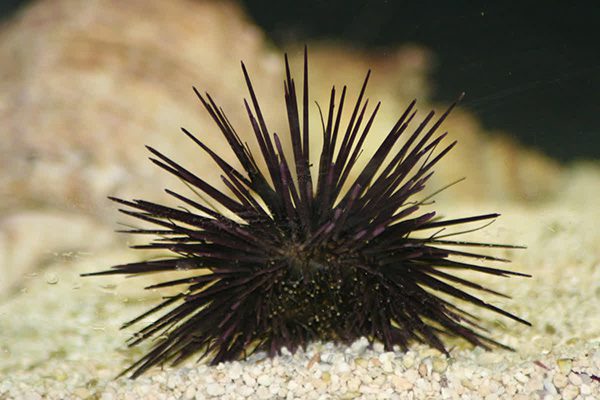The Reef’s Grazers: Ecology & Importance of Sea Urchin (Diadema spp.) in Marsa Alam
In the intricate tapestry of Marsa Alam’s Red Sea coral reefs, every organism, from the largest shark to the smallest alga, plays a role. Among the most critical, yet often underestimated, ecological players are the Sea Urchin (Diadema spp.). While their long, sharp spines might make them appear intimidating, these echinoderms are the unsung heroes of reef health, acting as the “lawnmowers” or “grazers” that maintain the delicate balance between coral and algae. Understanding the profound ecological importance of Diadema spp. in Marsa Alam provides crucial insight into the resilience and dynamics of these vibrant underwater cities. Sambo Divers Marsa Alam is dedicated to exploring and protecting these essential contributors to the marine environment.
The Herbivorous Gardener: Ecology and Behavior of Diadema spp.
Diadema spp. are primarily herbivorous grazers, meaning their diet consists predominantly of algae. Their ecological impact is significant:
- Algae Consumption: Using a unique, complex feeding apparatus called “Aristotle’s lantern” (a five-toothed jaw structure located on their underside), Diadema effectively scrapes and grazes on epilithic algae, turf algae, and algal films that grow on hard surfaces. They are highly efficient at keeping these fast-growing algae in check.
- Preventing Algal Overgrowth: This grazing activity is absolutely vital for the health of coral reefs. If algae are left unchecked, they can quickly outcompete and smother slow-growing corals, especially coral recruits (baby corals), preventing new coral growth and ultimately leading to a shift from a coral-dominated to an algae-dominated reef. Diadema essentially clears the substrate, creating open space for coral larvae to settle and thrive.
- “Urchin Barrens”: The importance of Diadema’s grazing is starkly illustrated by events where their populations suffer mass die-offs (e.g., from disease, as seen in the Caribbean). In the absence of Diadema, many reefs rapidly transition into “urchin barrens” or “algal barrens” where algae dominate, and coral cover declines dramatically. This highlights their critical role as keystone grazers.
- Nocturnal Activity (Common): While some species of Diadema can be seen grazing during the day, many are primarily nocturnal. During daylight hours, they often seek refuge in crevices, under ledges, or within the protective branches of corals to avoid predators. At night, they emerge en masse to graze openly on the reef. Divers on night dives in Marsa Alam will often see a much greater number of active Diadema.
- Movement: Sea urchins move slowly using their numerous tube feet, which are equipped with suction cups. Their spines also assist in locomotion, acting like stilts or levers.
- Defense Mechanisms: Their long, sharp, and often venomous spines are their primary defense against predators like triggerfish, pufferfish, and some large wrasses. When threatened, they can rapidly swivel their spines towards the perceived danger.
- Reproduction: Sea urchins typically reproduce through broadcast spawning, releasing eggs and sperm directly into the water column. The fertilized eggs develop into free-swimming larvae that eventually settle on the seafloor and metamorphose into juvenile urchins.
Threats and Conservation Challenges in Marsa Alam
Despite their spiny defenses, Diadema spp. populations are vulnerable to various threats, which can have cascading impacts on the health of Marsa Alam’s reefs:
- Disease: Mass mortality events due to disease have decimated Diadema populations in other parts of the world, leading to widespread algal overgrowth on affected reefs. While the Red Sea has generally been more resilient, global monitoring of urchin health is crucial.
- Overcollection: In some regions, sea urchins are collected for the aquarium trade or for their gonads (roe), which are considered a delicacy (uni in Japanese cuisine). While not a major issue in Marsa Alam’s protected areas, unsustainable harvesting elsewhere highlights their vulnerability.
- Habitat Degradation: Pollution (e.g., nutrient runoff, sedimentation) and physical damage to reefs can negatively impact sea urchin populations by degrading their foraging grounds or directly harming them.
- Predator Imbalance: The decline of natural predators that help regulate urchin populations (though Diadema has few due to its spines) or the increase of predators that target their competitors could indirectly affect their role.
Sambo Divers Marsa Alam: Protecting the Reef’s Essential Gardeners
The Sea Urchin (Diadema spp.) in Marsa Alam, with its seemingly formidable appearance, is in fact a crucial and diligent gardener of the Red Sea’s coral reefs. Sambo Divers Marsa Alam is committed to their protection through:
- Education and Awareness: We educate our divers about the vital ecological role of Diadema as grazers, explaining how their presence is a sign of a healthy, balanced reef.
- “No Touch” Policy: We strictly enforce a “look, don’t touch” policy. While primarily for diver safety, it also ensures these essential creatures are not stressed or harmed.
- Buoyancy and Reef Etiquette: Our briefings emphasize impeccable buoyancy control and careful movement, ensuring divers do not accidentally disturb or damage any part of the reef, including its spiny inhabitants.
- Supporting Reef Health: By promoting responsible diving and supporting overall reef conservation efforts, Sambo Divers contributes to creating an environment where Diadema and other crucial species can thrive.
To understand the subtle but profound importance of the Sea Urchin (Diadema spp.) in Marsa Alam is to gain a deeper appreciation for the intricate interdependencies within the Red Sea’s magnificent marine world. Join Sambo Divers Marsa Alam for an enriching dive experience, where you can safely observe these vital “reef grazers” and contribute to their ongoing protection.




0 Comment